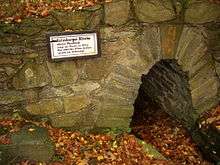Rösche

A Rösche is a German mining term that refers inter alia to a gullet (Wasserseige), a trench for draining water in the lower part of a mine gallery. In order to keep the actual gallery entrance (Stollenmundloch) free and guard against backflooding the Röschen were, in many cases, extended to below the entrance or led even further away, underground, to the nearest stream or river.[1]
By contrast the term Rösche was also used to describe the channels or "leats" through which the driving water for mining equipment was led into the pit (Aufschlagrösche or driving water leats) or out of the pit (Abfallrösche or drainage leats).[2] Unlike a gallery, a leat will have a gentle incline into the pit.
Also referred to as a Rösche are the tunnel-like sections of mining ditch (Kunstgraben) systems. These are not underground structures. In the Harz Mountains of Germany such a tunnel is also known as a Wasserlauf. See Upper Harz Water Tunnels.
A recess in the stowage for the extraction of ventilation in mining is called a Wetter-Rösche.[3]
References
- ↑ Albert Serlo: Leitfaden der Bergbaukunde. Erster Band, Verlag von Julius Springer, Berlin 1869
- ↑ E. Treptow, F. Wüst, W. Borchers: Bergbau und Hüttenwesen. Verlag und Druck Otto Spamer, Leipzig 1900
- ↑ Walter Bischoff, Heinz Bramann, Westfälische Berggewerkschaftskasse Bochum: Das kleine Bergbaulexikon. 7th ed., Verlag Glückauf GmbH, Essen 1988, ISBN 3-7739-0501-7